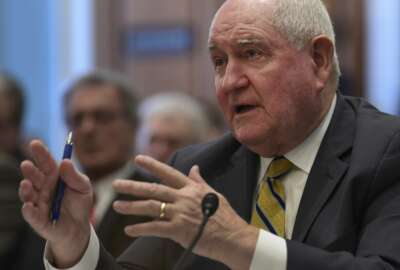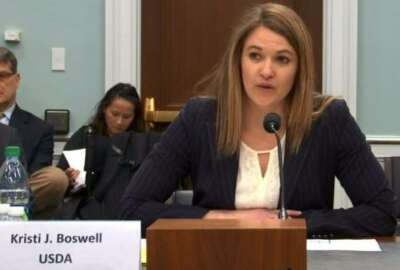
On heels of proposed USDA relocation, Perdue announces plans to realign employee workspaces
While employees await a decision about the department's plans for the proposed USDA relocation, Agriculture Secretary Sonny Perdue has announced a new initiativ...
While employees await a decision on the proposed USDA relocation, the Agriculture Department is starting a new initiative to review and reorganize its federally-owned and leased space in the national capital region — with the goal of reorganizing and consolidating physical workspaces for its employees.
Agriculture Secretary Sonny Perdue announced the initiative, called “OneNeighborhood,” in a video message to employees last week.
“Our goal is to make it easier for you to do your jobs by providing space where you’re close to your fellow employees with whom you work regularly,” Perdue said. “There are multiple agencies that are stretched across different offices on multiple floors of their own building.”
The goal of the initiative, Perdue said, is to improve collaboration within USDA agencies themselves.
Perdue used the Foreign Agricultural Service as an example. FAS employees work in offices on six different floors of the USDA South Building, he said.
“To work effectively as one team, agencies need to be in well-organized and thought-out spaces that promote productivity and collaboration,” Perdue said.
The goal of “OneNeighborhood,” as Perdue said in his video message, is to improve collaboration between the agency’s teams. It’s also a cost-saving initiative.
The message, however, came as a surprise to employees within USDA’s Economic Research Service (ERS) and National Institute of Food and Agriculture (NIFA), many of whom, under a separate proposal from the department, are supposed to be relocated to a still undetermined location outside of the Washington, D.C., metropolitan area.
ERS and NIFA employees received a one-page letter last week from Scott Hutchins, deputy undersecretary for research, education and economics at USDA, who acknowledged that these employees may have questions about how the new proposal may impact them and the pending relocation.
“This will result in relocating several agencies from currently leased space to either the South Building or the George Washington Carver Center,” the April 19 letter, which Federal News Network obtained, reads. “The employees of ERS and NIFA that are designated to remain in the Washington, D.C., region also will be relocated to one of these two sites. Otherwise, this initiative does not affect the relocation plan or schedule.”
Planning for “OneNeighborhood” has been underway for “some time,” Hutchins said, and intentional alignment of USDA employees will be planned “to minimize disruption with regular communication.”
USDA employees will receive a survey in the coming weeks to share their feedback about their workspaces, Perdue said.
Not all of the nearly 600 ERS and NIFA employees will move to the new location. The department told the House Appropriations Agriculture, Rural Development and Food and Drug Administration Subcommittee last month 76 ERS employees and 20 NIFA employees will remain in D.C., slightly more than what the agency predicted when it discussed the moves with employees back in August.
House Democrats have been highly critical of the USDA relocation proposal. Eight of them, led by House Majority Leader Steny Hoyer (D-Md.) and D.C. Del. Eleanor Holmes Norton, have urged appropriators not to give department the $25 million in funding it had requested for the USDA relocation.
The department is still reviewing proposals from a “short list” of 68 potential “areas of interest” for a new ERS and NIFA site. Hutchins told employees USDA leadership was working with its contractor, Ernst & Young, to review the site proposals, which he said were “voluminous and detailed.”
“We expect more details to be shared with employees over the next month,” the letter reads. “We remain committed to communicating with you regularly.”
The department hasn’t shared a cost-benefit analysis for the USDA relocation with Congress, and it doesn’t plan to until the agency’s leaders choose a final site location.
ERS and NIFA consider unionization
Meanwhile, employees at both ERS and NIFA are considering a push to unionize.
Employees at the Economic Research Service will vote May 9 to start a collective bargaining unit with the American Federation of Government Employees.
“We haven’t been promising the employees we can block the relocation,” Peter Winch, an AFGE special assistant, said. “We are telling them they’ll have a voice in the process, which they felt they haven’t had.”
Politico first reported the details of the unionization vote and timing.
Most ERS employees, with the exception of supervisors, can cast a ballot. The vote will run 11 a.m. to 2 p.m. Ballots will be counted at 2:15 that afternoon, Winch said.
If the employees vote to join a collective bargaining unit, AFGE will observe a five-day period for protests. The Federal Labor Relations Authority will issue an official certification, which would allow AFGE to be the exclusive representative for ERS employees.
Related Stories

Dozens of states express interest in hosting new locations for two USDA bureaus
 Exclusive
Exclusive USDA notifies Congress, sets initial timeline to relocate 600 DC-area employees
If the components decide to unionize, AFGE would likely place the ERS and NIFA units within Local 3403, Winch said. The local represents employees at the National Science Foundation and U.S. Geological Survey.
Winch said ERS and NIFA employees have expressed their concerns about the USDA relocation with AFGE, in addition to their worries about the department’s proposed budget cuts to the two bureaus.
Despite the department’s claims the relocation wouldn’t prompt reductions-in-force, USDA’s 2020 budget request suggests personnel cuts. The agency estimated it had 329 employees within ERS and proposed 160 employees for 2020. It’s unclear, however, how exactly USDA plans to cut the ERS workforce in half.
ERS and NIFA employees had also shared their unease with the possibility that USDA may ultimately choose a building in a city where the department already owns facilities to avoid a lengthy and complicated process with the General Services Administration, AFGE said.
Copyright © 2024 Federal News Network. All rights reserved. This website is not intended for users located within the European Economic Area.
Nicole Ogrysko is a reporter for Federal News Network focusing on the federal workforce and federal pay and benefits.
Follow @nogryskoWFED





